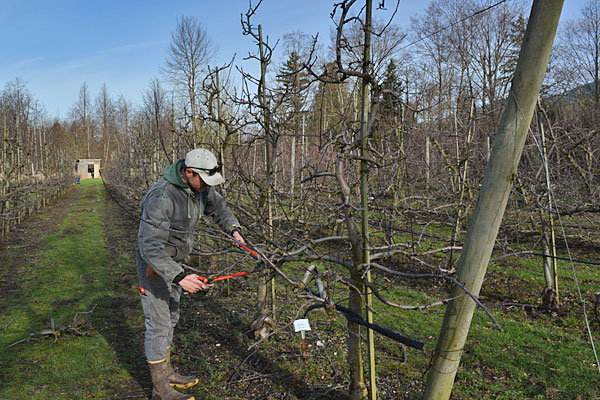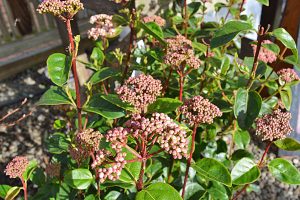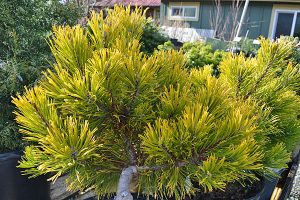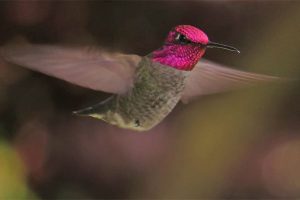The last few weeks have thrown the weather at us, hasn’t it? Cold, snow, then wet, wet, wet. But once in a while the sun peaks out and reminds us that spring is just around the corner. We took advantage of a little of that sunshine to walk around the farm- here are some updates.

Pruning in the pond orchard.
In the orchards
the crews are working their way through pruning the apples and pears. January through April is the best time to prune pome fruits- apples, pears, quince and medlar. Without the leaves, you can see the structure of the trees. Be sure to inspect for disease signs- scale, anthracnose, pseudomonas.- these problems are easier to spot during the winter. This process is called scouting, and we have more details in this post, Winter Scouting Fruit Trees.
Why Prune and Train Your Fruit Trees?
- To shape and balance your tree’s form
- To open the tree to light and air circulation
- To improve fruit quality
- To control vigor
Controlling branch vigor
Branch vigor refers to how strongly a branch is growing. Three major factors control branch vigor and flower bud formation: branch placement, branch angle, and caliper. These three things interact to balance and counterbalance growth within the tree.
- Branch placement (elevation) in tree. The lower the branch in the tree, the less vigor the branch has. The top of the tree will always be the strongest growing part of the tree
- Branch Angle. The more upright the branch, the more vigorously the branch will grow. If you take a vigorous branch and pull it down to a horizontal position, you can nearly stop all of the growth in that branch. We use a UV degradable tree training band for this, available at CMFC. Conversely, if you need a branch to grow more vigorously, pull it into a more upright position for a year.
- Caliper (thickness of branch). When comparing two branches in a tree, if the branches are the same elevation and growing at the same angle, the thicker branch will be more vigorous. This is why it is important to maintain older branches in the bottom of the tree.
You can control branch vigor by manipulating these three factors.
- Branch angle is the easiest way to manipulate branch vigor. By pulling upright branches more toward horizontal, you can decrease vigor. Experiment with branch angle to manage your fruit trees’ vigor. Ideal branch angle for fruit bud production should be between 60 and 90 degrees (90° is horizontal).
- Remember that branch caliper plays a key role in the vigor equation. Think of branch thickness as the width of a road. The wider the road, the more cars you can get down the road, or in this case energy (growth) though the branch. In an ideally shaped central leader tree, the lowest branches will be the thickest, and the topmost branches will be pruned and trained to reduce vigorous growth and encourage short, less vigorous, productive branches.
When you’re pruning apples and pears, remember the above principles of balancing your tree’s energy. You want larger branches to be lower in the tree. Flatter branches grow slower, upright branches grow faster. And whether you are working with open center or multiple leader trees, keep in mind that the highest tip in the tree will have apical dominance and grow faster, so try to balance the tips of all your leaders so they don’t grow out of balance.
We are not pruning our stone fruit trees yet. Why? Pruning stone fruits when they are still dormant can cause them to ‘wake up’ a little earlier than they should, making them more subject to frost damage. The peaches, Japanese plums and sweet cherries are just showing signs of breaking dormancy. The one exception to this wait-on-pruning-stone-fruits is if we spot black knot on a plum tree. Rule is- ALWAYS cut it out!
In the vineyards
We’re also pruning, both to collect wood for propagation, and to get the plants ready for spring. Grapes will ‘bleed’ sap quite readily from pruning cuts if pruned too late. We prune our wine grapes and table grapes a little differently. Wine grapes are trained using a cane pruning method called VSP or Vertical Shoot Positioning. Our table grapes are grown on a curtain trellis and managed through a spur pruning method. We’ve also gone through and pruned our kiwis and currants and gooseberries.
In the nursery

Viburnum tinus ‘Lisa Rose’

Carsten Wintergold Pine
Nursery season is in full swing. It’s a great time to plant bare root fruit trees, raspberries and strawberries, and other fruiting plants. But it’s also a great time to consider adding some pizzazz to your yard. In these gray days of late winter, you can have some bright spots to cheer you up. Yellow foliage can be a bit of sunshine in the gloom. Brightly colored bark is also a way to bring some cheer to winter. And of course, there are winter flowering plants that also can add some lift to your mood. In addition to brightening a winter day, these blooms can provide much needed nectar to resident Anna’s Hummingbirds and native pollinators.

Male Anna’s Hummingbird

